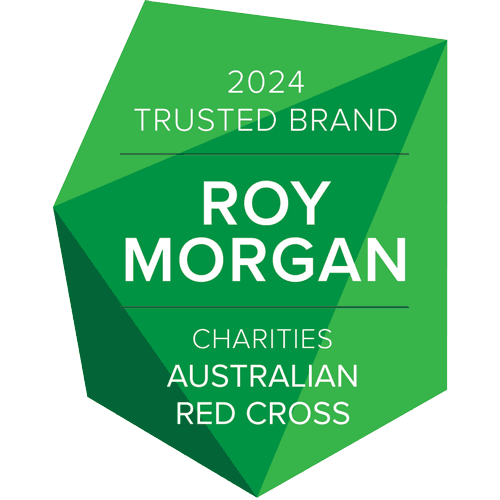Under the red cross emblem
Notes for teachers
Australian Red Cross would like to introduce Australian secondary students to the meaning of the red cross emblem – one of the most recognised and most important emblems in the world.
Purpose and direction of study
The red cross emblem was chosen by the drafters of the First Geneva Convention in 1864. They were looking for a symbol that could be worn on the battlefield to identify military medical personnel and the sick and injured they were assisting. They chose the reverse of the Swiss flag in honour of the Swiss founders of the Red Cross. As the Geneva Conventions, and indeed the entire body of rules that make up International Humanitarian Law, grew and grew, so did the protection it offered, to all those who were hors de combat, or not part of the fight.
For over 150 years, the red cross emblem has bought hope and protection and medical care/relief to millions of people caught up in the worst of armed conflict. It is a unique international symbol, and it saves lives. It is therefore vitally important that incidents in which the red cross has been ignored, targeted or used in deliberate acts of deceit are condemned.
Relevant subject learning areas
This unit could be included within school learning areas such as: History and Civics & Citizenship (with Australian Curriculum codes as below) but also Legal Studies, International Studies, Studies of Society and Environment (SOSE), Global Studies, Global/Current Affairs, Religion/Ethics, Media Studies or Communications or Graphics/Art.
The material could also be worth visiting by an Army Cadet group, learning the practical use of the emblem in military operations.
Australian Curriculum links (current as at 2014)
Knowledge and understanding
- The places where Australians fought and the nature of warfare during World War 1, including the Gallipoli campaign (ACDSEH095)
- The commemoration of World War 1, including the debates about the nature and significance of the Anzac legend (ACDSEH097)
- An examination of significant events of World War 2 (ACDSEH107); and
- The experiences of Australians during World War 2 (ACDSEH108)
- Continuing efforts post World War 2 to achieve lasting peace and security in the world, including Australia's involvement in UN peacekeeping (ACOKFH021)
- The obligations citizens may consider they have beyond their own national borders as active and informed global citizens (ACHCK039)
- Australia's roles and responsibilities at a global level, for example [….] in peacekeeping, participation in international organisations and the United Nations (ACHCK091)
- How Australia's international legal obligations shape Australian law and government policies (ACHCK093)
General capabilities
- Literacy
- Numeracy (see Market Research/polling in Exploration 3)
- Critical and creative thinking
- Personal and social capability
- Ethical understanding
- Intercultural understanding
Recommended ages
The unit is designed for those in middle school years (8-10).
Timing
Each Exploration, if tackled in any depth, would seem to demand two x 40-minute class periods, as a minimum.
Resources provided
Under the red cross emblem
Powerpoint presentation, 25 slides, with brief speaking notes for each
Starter Reading
These four documents give essential context to brief teachers, but they may also be used as student handouts
Three blocks of Explore - Research, think, do
These are our options for class activity and engagement.
Activities are provided on three themes. After a general overview of how and why the red cross emblem came to be set apart in international humanitarian law, each Exploration is stand-alone.
Exploration 1 takes the legend of Simpson and his donkey from World War 1 Australian history, and looks at what it means for military medical personnel to wear the red cross brassard, even in contemporary contexts such as Iraq and Afghanistan.
Exploration 2 looks at the World War 2 sinking of the clearly marked Australian hospital ship Centaur in 1942, and how this breached the Geneva Conventions. Students question the place of war crimes trials and whether the defence of 'I was only following orders' is acceptable.
Exploration 3 asks students to poll how much the distinctive status of the red cross is understood in Australia today and prompts them to value and protect it as something quite different from a logo or trademark.
Web links
'The Nurse: Interview with Christine Foletti', by Bev Patterson, in Australian Red Cross IHL Magazine 'Australia and 60 years of the Geneva Conventions', No 16, Issue 1, 2009, p 8-9
'When protection fails: AHS Centaur' by Lynette Lye and Annabel McConnachie, in Australian Red Cross IHL Magazine 'Protection for Humanitarian Workers' No 17, Issue 1, 2010, p 10-11
'Protect this emblem because it protects lives' - Australian Red Cross brochure
Explore - Research, think, do
What's in an emblem?
All three Explorations make use of the Powerpoint presentation 'Under the red cross emblem', with PPT Slides 1-7 providing the general introduction.
All assume a grasp of essential context from Starter Reading: The history and meaning of the red cross emblem
Exploration 1: Military medical personnel and the emblem
- PPT Slides 8-12 specifically
- Starter Reading: The Life of Private John Simpson Fitzpatrick
- Detailed activities of Exploration 1
Exploration 2: Australian Hospital Ship Centaur AHS-47 in World War 2
- PPT Slides 13-19 specifically
- Starter Reading: The AHS-47 Centaur
- Detailed activities of Exploration 2
Exploration 3: Protecting the emblem in Australia today
- PPT Slides 20-25 specifically
- Starter Reading: The Misuse of the Emblem
- Detailed activities of Exploration 3
Charity donations of $2 or more to Australian Red Cross may be tax deductible in Australia. Site protected by Google Invisible reCAPTCHA. © Australian Red Cross 2025. ABN 50 169 561 394
